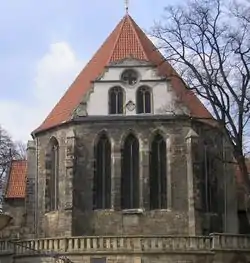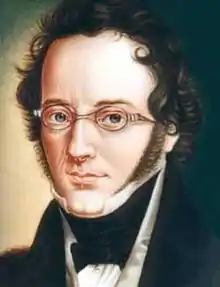Arnstadt
Arnstadt (German pronunciation: [ˈarnʃtat] (![]() listen)) is a town in Ilm-Kreis, Thuringia, Germany, on the river Gera about 20 kilometres south of Erfurt, the capital of Thuringia. Arnstadt is one of the oldest towns in Thuringia, and has a well-preserved historic centre with a partially preserved town wall. The town is nicknamed Das Tor zum Thüringer Wald ("The Gateway to the Thuringian Forest") because of its location on the northern edge of that forest. Arnstadt has a population of some 27,000. The city centre is on the west side of Gera. The municipality has absorbed several neighbouring municipalities: Angelhausen–Oberndorf (1922), Siegelbach (1994), Rudisleben (1999) and Wipfratal (2019). The neighbouring municipalities are Amt Wachsenburg, Alkersleben, Dornheim, Bösleben-Wüllersleben, Stadtilm, Ilmenau, Plaue and Geratal.
listen)) is a town in Ilm-Kreis, Thuringia, Germany, on the river Gera about 20 kilometres south of Erfurt, the capital of Thuringia. Arnstadt is one of the oldest towns in Thuringia, and has a well-preserved historic centre with a partially preserved town wall. The town is nicknamed Das Tor zum Thüringer Wald ("The Gateway to the Thuringian Forest") because of its location on the northern edge of that forest. Arnstadt has a population of some 27,000. The city centre is on the west side of Gera. The municipality has absorbed several neighbouring municipalities: Angelhausen–Oberndorf (1922), Siegelbach (1994), Rudisleben (1999) and Wipfratal (2019). The neighbouring municipalities are Amt Wachsenburg, Alkersleben, Dornheim, Bösleben-Wüllersleben, Stadtilm, Ilmenau, Plaue and Geratal.
Arnstadt | |
|---|---|
 The Bach Church | |
 Flag  Coat of arms | |
Location of Arnstadt within Ilm-Kreis district  | |
 Arnstadt  Arnstadt | |
| Coordinates: 50°50′3″N 10°56′47″E | |
| Country | Germany |
| State | Thuringia |
| District | Ilm-Kreis |
| Subdivisions | 6 |
| Government | |
| • Mayor | Frank Spilling (Ind.) |
| Area | |
| • Total | 105.11 km2 (40.58 sq mi) |
| Elevation | 288 m (945 ft) |
| Population (2019-12-31)[1] | |
| • Total | 27,314 |
| • Density | 260/km2 (670/sq mi) |
| Time zone | UTC+01:00 (CET) |
| • Summer (DST) | UTC+02:00 (CEST) |
| Postal codes | 99301–99310 |
| Dialling codes | 03628 |
| Vehicle registration | IK, ARN, IL |
| Website | www.arnstadt.de |
History
A deed of gift issued 1 May 704 in Würzburg by the Thuringian Duke Hedan II to the Anglo-Saxon bishop Willibrord of Utrecht is the first written reference to Arnstadt ("Arnestati"), along with two other towns—the oldest documented reference of settlements in Thuringia and central and eastern Germany.[2] In 726, Arnstadt passed to the Abbey of Echternach, and later to the Abbey of Hersfeld. According to historian August Beck, in 925 the territories of Henry I were extended as a bulwark against the invading Magyars.[3] On 17 December 954, Holy Roman Emperor Otto I made peace in Arnstadt with his rebellious son Liudolf of Swabia and another son, William, whom he appointed Archbishop of Mainz, and decided that the Liebfrauenkirche (Church of our Lady) would be built.
In the 12th century a part of Arnstadt fell under the rule of the Counts of Kevernburg. On 8 March 1198 the princes of the Holy Roman Empire gathered in Arnstadt and elected Philip of Swabia as King of Germany. In 1220 Arnstadt was first described as a civitas, that is, a city. On 21 April 1266, the abbot of the Abbey of Hersfeld granted a charter; thereafter, Arnstadt became a hub for trade in timber, grain, wine and wood.
After the extinction of the Kevernburg family from 1302 to 1306, the counts of Schwarzburg took possession of Arnstadt. Attempts by Erfurt 1342 and 1345 to seize what was now a wealthy town failed due to the strong attachment. Arnstadt's prosperity was based on the milling industry, the cloth-making trade, tanneries, and trade in wine, woad, wood, grain, wool, and vegetables.
On 30 January 1349, Count Günther XXI of Schwarzburg, an adversary of King Charles IV, was elected and crowned sovereign of Arnstadt in Frankfurt. He renounced this title on 26 May for 20,000 silver marks. A 1404 reference was found in 2000 to Bratwurst originating in Arnstadt, therefore the town claims its invention. In 1496, the Schwarzburg domains were divided into the lordships of Schwarzburg-Rudolstadt and Schwarzburg-Sondershausen, to which Arnstadt belonged. During the German Peasants' War 95 participants in the uprising were beheaded as ringleaders in the Arnstadt marketplace, on 17 June and 2 August 1525. The city was forced to pay 3000 guilders for supporting the insurgents. In 1531 the Reformation was introduced into Arnstadt. As a result, the Franciscan maidens' convent, and subsequently the Franciscan mendicant convent (Barfüßerkloster) were secularized. From 1581 the church of the former Barfüßerkloster (now the Oberkirche) was the main church of the city. In 1553, work began on the count's residence, Neideck Castle. The water palace was completed in 1560.
With the onset of industrialisation, a residential area emerged to the west and south of the old town, and industrial areas to the north. During the Second World War, it was the site of a prisoner-of-war camp, mainly for Poles and Russians. 1,700 prisoners were housed in tents that contained only 100 bunks. The camp was liberated by American Forces in April 1945. A number of mass graves were discovered. 1,200 civilians from the neighbouring city of Weimar were brought on a forced tour of the camp. This included a "parchment display" which displayed a "lampshade made of human skin." The display also included pieces of skin used for painting pictures.[4] After the Second World War, the town expanded further to the north along the Geratals, new residential areas emerged in the 1970s and 80s, in the east and southeast of Arnstadt, including the residential Raven Hold. Arnstadt is a manufacturing centre with glassworks and foundries, a solar panel production plant, and glove-manufacturing and wood-finishing businesses.
Main sights

Arnstadt has a beautifully kept old city, restricted to pedestrian traffic. Its noteworthy buildings include:
- the 13th-century Church of Our Lady
- an 18th-century palace
- the Bach Church (formerly the New Church)
The composer Johann Sebastian Bach, whose family lived for generations in the vicinity of Arnstadt, became the organist at the New Church in 1703 while he was still in his teens. He stayed there until 1707. Bach had a high opinion of Johann Friedrich Wender, the organ-builder who had recently constructed the church's organ.[5] While there is some uncertainty about which of his surviving compositions were produced in Arnstadt, there is evidence that the Wender organ, which still survives, allowed Bach to experiment with unusual modulations and harmonies. Many Bach scholars believe his well-known "Toccata and Fugue in D Minor" was composed with the Arnstadt organ in mind.[6]
Miscellaneous
The annual precipitation averages 487 mm.
The town hosts an annual high jump meet – Hochsprung mit Musik – which attracts some of the world's foremost high jumpers. Kajsa Bergqvist set a world record in Arnstadt's Sporthalle am Jahn-sportpark in 2006.[7]
Gallery
 Architectural model of the Liebfrauenkirche in Arnstadt
Architectural model of the Liebfrauenkirche in Arnstadt The palace of Elisabeth Albertine von Anhalt-Bernburg
The palace of Elisabeth Albertine von Anhalt-Bernburg The "Riedtor" and the "Jakobsturm"
The "Riedtor" and the "Jakobsturm"
People

- Willibald Alexis, (1798-1871), historical novelist
- Johann Sebastian Bach, (1685-1750), famous composer and musician
- Ludwig Bechstein, (1801-1860), writer
- Johann Christian von Hellbach
- Marcel Kittel, (born 1988), cyclist
- Johann Friedrich Wender, (1655-1729), organ builder
- Anton-Heinrich Heller, (born 1999), artist & salesman
- Inspector Hector, (born 2018), doggo and fren of Anton
- Bernd Heller, (born 1947), famous leader of the HELLER Maschinen & Technologie AG and logistics expert
- Seniorendreiradexperte, (born 1963), racing driver
Sons and daughters of the town

- Johann Christoph Bach (1642–1703), composer
- Johann Michael Bach (1648–1694), composer
- August Johann Rösel von Rosenhof (1705–1759), naturalist
- Johann Christian Gottlieb Ernesti (1756-1802), was German classical scholar
- Ernst August Nicolai (1800–1875), naturalist
- Friedrich Filitz (1804–1876), composer and musicologist
- E. Marlitt (1825–1887), writer
- Bernhard Stade (1848–1906), theologian
- Katrin Schreiter (born 1969), athlete
- Kornelia Greßler (born 1970), women's swimming
- Sandra Wallenhorst (born 1972), former triathlete and duathlete
- Thomas Ziegler (born 1980), cyclist
- Theresa Senff (born 1982), cyclist
- Marcel Kittel (born 1988), cyclist
Notes
- "Bevölkerung der Gemeinden, erfüllenden Gemeinden und Verwaltungsgemeinschaften in Thüringen Gebietsstand: 31.12.2019". Thüringer Landesamt für Statistik (in German). August 2020.
- Georg Heinrich Pertz u. a. (Hrsg.): Scriptores (in Folio) 23: Chronica aevi Suevici. Hannover 1874, S. 55–56 (Monumenta Germaniae Historica, Digitalisat)
- August Beck: Geschichte des gothaischen Landes, Vol. I, Gotha, 1868, S. 31.
- Nazi Concentration Camps American army documentary produced and presented as evidence at the Nuremberg war crimes trial of Hermann Göring and twenty other Nazi leaders.
- "Johann Friedrich Wender (Organ Builder)". Retrieved December 23, 2014.
- Gardiner, John Eliot. "Cantatas for the first Sunday after Easter (Quasimodogeniti)" (PDF). Archived from the original (PDF) on 4 March 2016. Retrieved 22 January 2015.
- Bergqvist joy at breaking record. BBC Sport (2006-02-05). Retrieved on 2010-02-09.
External links
 Media related to Arnstadt at Wikimedia Commons
Media related to Arnstadt at Wikimedia Commons
